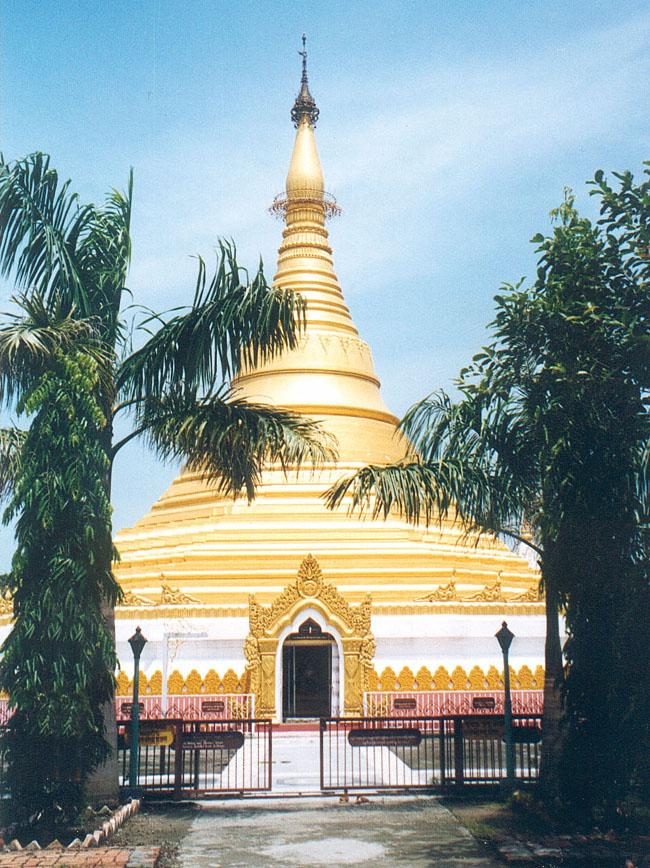Buddha was born at Lumbini in southern Nepal on a full moon day in 623 B.C. The importance of Lumbini is testified by the Mauryan Emperor Ashoka who visited Lumbini in order to pay homage to the great Master and erected a pillar in 249 B.C. to indicate the birth place of Buddha. Near the Ashokan pillar is the newly renovated Mayadevi Temple also houses. The marker stone discovered in 1996 AD which depicts the exact spot where the Buddha was born. It snow kept in bulletproof glass in the Mayadevi Temple.
The Mayadevi temple was renovated in 2003 on the 2547th auspicious birth anniversary of the Buddha and houses ruins of the early period dating back from 3rd century BC to the 7th century AD. Near the temple is situated is situated the Puskarni pond where Queen Mayadevi-the Buddha’s mother- had given the first purificatory bath to the infant Buddha.
In 1896, excavations by General Khadga Shumsher Rana of Nepal and renowned archeologist Dr. A Fuhrer shed light on various aspects of the life of Buddha. In 1898, the British government deputed P.C. Mukherjee who confirmed the exact location of Aurorakot as the birth place of Kannakmuni Buddha and Gotihawa as the native place of Kakruchhanda Buddha who existed before the Shakyamuni Buddha and Lumbini as birthplace of Shakyamuni Buddha. He also claimed Devdaha to be the maternal home of Buddha and Tilaurakot ot be the exact site of Kapilvastu-the ancient capital of the Shakya Kingdom.
Shortly after the Buddha attained enlightenment at the age of 36, he delivered his first sermon, in which he laid out the essential framework upon which all his later teachings were based. This framework consists of the four Truths and the Eight fold path, which identifies the source of sufferings and the path towards the cessation of sufferings and the attainment of Salvation.
In order to develop Lumbini as a pilgrimage center and a fountain of World peace, Prof. Kenzo Tange of Japan was assigned to create the Lumbini Masterplan by UN which was jointly approved by the Government of Nepal and UN in 1978. The Master Plan includes canals, gardens, library, museum, monastic zones and areas for amenities. Lumbini Development Trust is responsible for the overall development of Lumbini. Listed as a World Heritage Site by UNESCO in December 1997, Lumbini is being developed with international support. There are different Vihars and Monastries constructed by different countries like Korea, Myanmar, Thailand, Vietnam, Cambodia, Japan, Germany, France, Austria, India, Srilanka, China and Nepal.
General Information
Access: From Kathmandu, fly to Gautam Buddha Airport in Bhairahawa (Siddharatha Nagar Municipality, 30 Minutes) and then drive (22 km) to Lumbini. Overland from Kathmandu to Bhairahawa is 300 km (9 hours).
Getting around: The places to see in Lumbini are scattered over an area of roughly 3 sq miles. There are manual three-wheelers to get around the Lumbini complex.
Climate : Temperature 40 degrees Celsius maximum, 7 degrees minimum. The rainy season lasts June-September.
Additional info: Lumbini Development Trust, Lumbini; Tel: +977-71-580189, 580200, Fax: 580181. Kathmandu office: Bhrikutimandap, Tel: +977-01-4268285,4268494,
URL:www.lumbinitrust.org, email:
dntt@wlink.com.np . Accommodation : Lumbini offers good hotels that are equipped with modern amenities. Visitors can also stay in Lumbini or the nearby town of Bhairahawa.
Attractions : Lumbini tour, Buddist circuit tour, Village tour, Monastery tour, Meditation, Archaeological tour, Crane Sancturay and Wet land tour. Great celebration takes place in Buddha Purnima (April- May).































No comments: